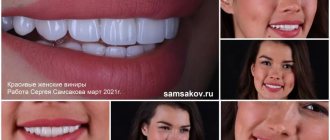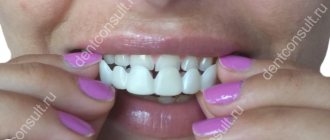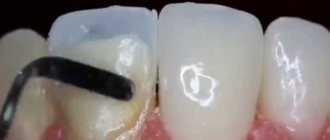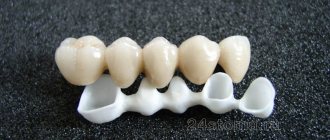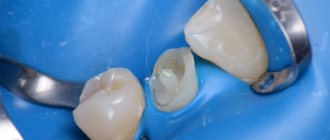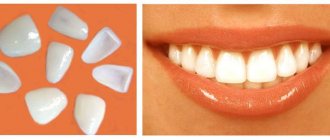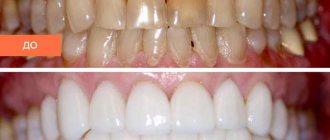Over the course of a person's life, cracks sometimes form in the enamel of teeth. It can break off, wear off, or become covered with irregularities. Visual errors sometimes haunt the patient from childhood. Having gained access to the possibilities of modern medicine, an adult strives to take advantage of them and add shine and shine to his own smile.
Therapeutic veneers are extremely popular as an alternative to invasive orthopedic intervention in the functionality of the anterior teeth. Due to their reasonable price, they have surpassed expensive ceramic linings in the popularity rankings. The advantages of the mentioned technique reconcile patients with some disadvantages, but the issue of the appropriateness of installing therapeutic veneers is always discussed with the doctor in advance.
What are therapeutic veneers
Therapeutic veneers are additionally called composite veneers due to their composition. Onlays consist of a special light-hardening material that allows you to smooth out roughness, breaks and cracks on the front surface of the tooth, or change its shape.
Another name for these veneers is direct. It is explained by the way the structure is installed. The component is layered onto the vestibular surface of the front teeth and is immediately corrected. This is a creative work that requires the dentist to have experience and artistic vision, and the ability to foresee the result. Direct veneers are created in the patient's mouth in 2-3 hours. Therefore, a person no longer has to wait many days before he gets a beautiful smile and returns to his daily activities transformed.
Advantages and disadvantages of veneers using the direct method
The advantages of the technique are mainly associated with the relative simplicity and high speed of production of onlays:
- Veneers are installed in one clinic visit. No preliminary making of impressions, fitting or installation of temporary structures is required.
- The enamel is turned in a gentle way, to a depth of up to 0.7 mm, sometimes less. If the tooth is not sick, manipulations are kept to a minimum. For example, only part of the tooth is processed or no preparation is done at all.
- Modern photocomposite materials reliably imitate human dental tissue. As a result, the therapeutic veneer is practically indistinguishable from adjacent healthy teeth.
- Accidental damage to part of the veneer will not become an obstacle to correcting the situation. At the appointment, the doctor will remove the layered composition that has lost its usefulness and install a new one.
- The price of direct veneering is truly considered budgetary and is available to everyone, including students and retirees. Ceramic structures are much more expensive.
The latter circumstance often becomes decisive. However, along with the advantages, the doctor certainly voices the disadvantages of the technique, giving the person the opportunity to make an informed choice.
Direct composite veneers are a quick way to improve the aesthetic characteristics of teeth
L. A. Lobovkina
Ph.D., doctor of the highest category, head of the treatment and prophylactic department of Branch No. 6 of the Federal State Institution “GVKG im. Burdenko" of the Ministry of Defense of the Russian Federation (Moscow)
A. M. Romanov
Candidate of Medical Sciences, Chief Physician of the Implamed Clinic (Moscow)
Currently, more and more work is being performed not only to restore functionality, but also to restore or improve aesthetics, which is not associated with the presence of carious cavities. Modern composite materials make it possible to produce highly aesthetic and at the same time minimally invasive restorations (Juan Manuel Licares Sixto, 2015).
The evolution of materials, techniques and concepts allows doctors to solve a wide range of problems in everyday practice in a conservative way, using the well-proven method of direct composite restorations.
However, controversial situations still arise between the general practitioner and the orthopedist regarding how to make a veneer when the coronal part of the tooth is destroyed by more than 50%. An important factor in choosing between indirect and direct restoration is cost [2, 3]. As you know, the cost of indirect restoration is always higher than direct restoration. Due to the global economic crisis, many patients are trying to save money on dental treatment. Consequently, direct restoration in such cases is often the ideal method to quickly solve the esthetic problem and create a reliable, inexpensive restoration [1].
Clinical case
Patient V., 25 years old, applied to the therapeutic dentistry clinic with complaints of an aesthetic defect in teeth 1.1, 2.1 and 2.2 (Fig. 1).
Rice. 1. Teeth 1.1, 2.1 and 2.2: initial situation.
Before starting treatment, the initial situation was recorded using photographs, as well as a comprehensive clinical and x-ray examination of the patient, and situational models were made. The patient was recommended to have ceramic veneers made for teeth 1.2, 1.1, 2.1 and 2.2. However, she insisted on restoring her teeth using veneers made of composite materials.
Preliminary stages included professional, individual oral hygiene; discussion with the patient of the features of the restoration and mutual responsibility for the results of the work.
After anesthesia, the tooth surface is cleaned of organic food debris and pellicles using a brush and fluoride-free paste (Fig. 2).
Rice. 2. The tooth surface is cleaned with a brush and fluoride-free paste.
In our work, we give preference to Clint paste (VOCO), which creates more comfortable conditions for the doctor, as it has high adhesive characteristics and does not splash in all directions during work. The stage of cleansing the tooth surface from organic food debris and pellicles is not yet carried out by all dentists, despite its importance. The pellicle has an organic basis; it is not dissolved by phosphoric acid. Consequently, its presence on the tooth surface will reduce the adhesion of the filling material to the enamel surface. And this, in turn, will lead to unsatisfactory long-term results. Therefore, this stage must be carried out even if the patient has good oral hygiene and in the absence of visible dental plaque.
The next stage was the selection of material for future restoration.
For greater color consistency, it is recommended to also moisten the color template of the filling material with water.
According to the “concept of natural layer-by-layer restoration,” the shade selection procedure consists of 2 stages:
1) choice of color saturation of dentin in the cervical area, where the enamel is thinnest;
2) choice of enamel shade - along the cutting edge, where the thickest layer of enamel is located (Fig. 3).
Rice. 3. Determining the color of the future restoration.
Next, the teeth were prepared. First, using a depth marker bur (SS WHITE) (Fig. 4), the degree of excision of the vestibular surface of the crown of tooth 2.1 is outlined: grooves with a depth of 0.3 mm are sawn. Then the vestibular surface between the grooves is leveled with a cone-shaped diamond bur. We pay attention to the features of preparation of the gingival wall. It should be placed at the level of the gingival margin or 0.1-0.3 mm below it.
Rice. 4. Using a bur as a depth marker.
After this, the body of the tooth is processed, grooves are formed on the medial and distal edges. A pear-shaped bur is used to form the boundaries of the veneer with the tooth tissue. They are located in accordance with aesthetic expediency - in areas not visible during direct inspection. At the same stage, the “old” fillings were removed (Fig. 5).
Rice. 5. View of teeth 1.1 and 2.1 after removal of the “old” fillings.
An important technological point is the adequate formation of the veneer’s border with the tooth tissue. The fact is that the creation of a gentle, wide bevel often leads to the fact that the stresses arising at the border of the veneer with the tooth enamel cause a violation of the marginal fit, “seam leakage” and the appearance of marginal staining of the restorations.
Taking this into account, when preparing a tooth for a composite veneer, we recommend creating a deep groove-shaped bevel with the formation of a “dog-leg” groove in the gingival contact area.
The final stage of preparation is finishing the edges of the enamel with an ultra-fine-grain diamond bur (with a yellow or red stripe).
To date, many developers and manufacturers of dental materials have announced the creation of composite materials that are focused on reproducing the structure of enamel and dentin of teeth, as close as possible to the natural one [3]. One of them is “Amaris” (VOCO, Germany), which was used for dental restoration in our case. This is a composite with a new shade system, specially developed for the creation of esthetic restorations, with which the dentist can quickly and accurately select the desired shades.
This composite material is highly filled, as it contains 80% microhybrid filler. The uniform distribution of filler particles and their fine dispersion determine the special smoothness of the surface, thanks to which the material is perfectly polished. Over time, the high-quality structure of the material fully justifies itself: the surface of the restoration remains smooth and has a “dry” shine [4]. To convey individual characteristics, there are two special shades: 1) a high-opaque shade (HO), which acts as a masking agent, which is used when necessary to hide highly pigmented dentin, disguise a pin, or revive the color of a pulpless tooth; 2) highly transparent (HT), designed to restore the cutting edge and simulate zones of transparency.
The enamel and dentin were conditioned with 35% orthophosphoric acid (Vococid gel) (Fig. 6).
Rice. 6. Stage of conditioning of enamel and dentin.
After applying the 5th generation one-component adhesive system “Solobond M” (VOCO, Germany), the high-flow composite “Amaris flow” was used as a super-adaptive layer. First, tooth 1.1 was restored. Dentin shade O3 was added (Fig. 7). Next, using a silicone key made before tooth preparation, the palatal wall of tooth 2.1 was restored. Then the dentinal layer O3 of the Amaris composite was added and mamelons were formed (Fig. 8).
Rice. 7. Adding dentin shade “Amaris”. Rice. 8. Teeth 1.1 and 2.1: restoration stage.
To obtain a good aesthetic result, the enamel shade on the vestibular surface is applied in one layer 0.5 mm thick and distributed using a brush moistened with adhesive. Considering the fact that the patient had no zones of transparency (in most cases they disappear by the age of 25-30), a transparent shade was not used during the restoration (Fig. 9).
Rice. 9. Teeth 2.1 and 2.2 after restoration with the Amaris composite material.
After this, macro- and microcontouring of the restoration was performed: the contact and cervical area - with discs of various grain sizes, the vestibular surface - with peak-shaped diamond burs of low and ultra-low abrasiveness. The restoration was then polished using universal polishing heads. In our work, we use universal polishing heads JAZZ Supreme Polishers ( SS WHITE ), which consist of diamond microparticles of various sizes enclosed in a synthetic rubber matrix. This one-step system produces superior shine faster and without the need for polishing paste. Jazz Supreme Polishers set contains four different shaped polishing heads (flame, cup, disc and small flame) in an autoclavable container. The final appearance of the restoration of teeth 1.1 and 2.1 is shown in the figure (Fig. 10).
Rice. 10. Teeth 1.1 and 2.1: final appearance after the Amaris restoration.
At the next visit (1 week later), restoration of tooth 2.2 and correction of the anatomical characteristics of teeth 1.1 and 2.1 (width alignment) were carried out.
Conclusion
The production of direct composite veneers requires an exceptionally high level of skill in both the science and art of dentistry (Havori E., 2015).
The use of the Amaris composite material allows you to achieve very good optical results in just one visit. The advantage of this composite is its excellent fluorescence, which differs little from natural tooth tissue under ultraviolet light. Knowing the properties of the material and following the manufacturer’s recommendations, especially when using adhesive technologies, is the main condition for achieving a predictable and durable result, leading to the complete satisfaction of the dentist and, of course, the patient.
Obvious disadvantages of direct veneering:
- Therapeutic veneers gradually change shade. The microporous structure absorbs the pigments of food elements over the years and becomes darker. To prevent the development of such a situation, the patient must limit his own diet and try to avoid foods with bright, persistent enamel coloring. The list includes red wine, beets, strong tea, etc.
- Shorter service life compared to ceramic plates. This is explained by the loose fit of the composite to the tooth tissues, which provokes the accumulation of plaque in the lacunae and crevices. Bacteria readily inhabit these cavities, contributing to the development of caries.
- Hardness bordering on brittleness. Direct veneers crack when subjected to strong force and cannot be restored.
The listed disadvantages can be limited if you follow the rules of hygiene and take care of the installed veneer. Medical technologies do not stand still, and the first two disadvantages gradually cease to be decisive for the patient. The materials used are constantly improving the adhesive ability and expanding the possibilities of extending the service life.
Luxneers - veneers are installed without tooth preparation and without pain. Diastema, tremata, curvature, salts of teeth are corrected. It is advisable to bring a panoramic image of the OPTG to the consultation.
Lumineers
Lumineers
A new direction in aesthetic dentistry has recently been the installation of lumineers . They are also called Hollywood teeth veneers. American manufactures and supplies such linings.
The plates are made from high-strength ceramics, the plate thickness of which is only 0.2-0.3 mm.
Installing lumineers, unlike ceramic veneers, has a number of positive aspects:
- before installing ultra-thin veneers, no heavy grinding of the tooth is required; only a minimal layer of enamel is removed;
- since the installation procedure does not require tooth preparation, therefore, it is painless and does not require anesthesia;
- resistance to mechanical loads, do not wear out over time;
- these linings are glued to a special composition insoluble in saliva, which contains a substance - fluoride, which has a beneficial effect on the teeth, and thereby protects against secondary caries;
- the ability to choose the color of the lining identical to the natural color of the patient’s teeth;
- The service life of such veneers is up to 20 years.
Despite the advantages of lumineers, there are also disadvantages:
- since lumineers are produced only in one place - in America, patients have to wait about 2 months before installation;
- The cost of installing one lumineer is several times higher than the cost of a veneer.
Indications for installation of veneers
Therapeutic veneers are indicated when only the facial surface of the tooth is destroyed. If the problem lies in the side or back, a direct veneer is not sustainable.
Most often, a composite is used to cover cracked enamel, stains on the surface, or a noticeable boundary between the filling material and the living tissues of the tooth that arose during the treatment of caries. Sometimes in these cases the enamel is ground down locally, which reduces the area of trauma.
Direct veneers are excellent at hiding pigment spots that cannot be bleached. For example, indications for installing an onlay will be tetracycline teeth.
The increased sensitivity of teeth to whitening components will lose its significance if the tooth changes its shade to snow-white by layering the composite substance. It can correct the shape of a tooth, eliminate diastema, correct size, and eliminate minor curvature.
It happens that tooth enamel wears away over the years, then direct veneers will come to the rescue. They will also correct the situation with damaged enamel after wearing braces for a long time.
Veneers without grinding - fact or fiction?
Preparing teeth for veneers raises many questions among patients, and marketers have a lot of opportunities to attract clients to the clinic through loud slogans like “Veneers without grinding!” What's the catch? The fact is that in almost 95% of cases you have to use turning. It is logical that patients who require veneering do not have perfect teeth, and in order to correct their shape and size using microprostheses, preparation is required. Grinding is not necessary if the teeth are small and there are gaps between them. Crowding, medium or large teeth are indications for grinding. Otherwise, you will not get a Hollywood smile, but a pitiful imitation of it, created from Orbit pads.
Contraindications
However, in most cases, veneers will not replace the braces system. A thin plate cannot hold the tooth in an orthodontically correct position. Therefore, significant occlusion will become an obstacle to the application of a composite in order to improve the aesthetics of the dentition.
Addition to the list of contraindications:
- Teeth destroyed by caries. The installation of a veneer also excludes the case when the filling makes up a large part of the tooth, especially if it occupies almost the entire vestibular surface.
- Periodontal inflammation;
- Unsatisfactory hygienic condition of the oral cavity;
- Tendency to uncontrollable grinding of teeth, mainly in sleep;
- Engaging in contact sports (boxing, martial arts), when there is a high risk of breaking a fragile veneer;
- Indulging in the habit of cracking seeds with incisors, biting threads, etc.
Also, in most cases, the doctor will refuse to install a composite veneer on the surface of a chewing tooth, where the load on the component will be too great to ensure that it remains intact.
How direct veneers are installed
The installation of therapeutic veneers occurs directly during a visit to the dentist’s office.
- The doctor examines the condition of the patient’s teeth and collects information. If there are no obstacles, teeth are cleaned and tartar is removed. Sometimes preliminary treatment of caries is required, then the installation of veneers is postponed.
- The enamel is prepared to a small thickness, sometimes only locally, not over the entire surface of the tooth. At the patient's request, anesthesia is used; there is no need to endure pain.
- Then etching of the exposed area is used to improve the adhesion of the composite material to the tissues of the living tooth.
- The doctor applies the substance of the future veneer layer by layer onto the prepared tooth, simultaneously forming and fixing the composite. An LED or UV lamp is used for curing.
- Finally, grinding and final polishing are performed, as a result of which the tooth acquires the appearance of a natural one.
Some patients attribute the need to keep their mouth open for a long time as a subjective disadvantage. To prevent muscles from getting tired, the doctor uses intermaxillary inlays. However, you need to psychologically prepare for possible slight discomfort.
Dental veneers: price - what does it depend on?
Almost all dental clinics in Moscow offer veneers - varying in cost, including inexpensive ones. However, not all of these proposals are equally “good”. What to do? How do you know who is trustworthy, where to order veneers, and who to stay away from? How much do high-quality veneers cost for upper and lower teeth?
Our recommendations on how to navigate the clinics:
- Look at the clinic's team of doctors. Particular attention is paid to orthopedic dentists (experience, advanced training).
- Pay attention to the clinic’s equipment: computed tomographs, dental microscopes (the doctor must work with magnification!), the use of rubber dam (latex insulation). Only with such equipment and materials can a doctor do a high-quality job, install veneers with minimal preparation, practically without grinding.
- The main thing is to look at the work of specific doctors in the BEFORE/AFTER format. Choose a podiatrist whose ideas about aesthetics are similar to yours.
Our clinic’s orthopedists are specialists in aesthetic dentistry. We make veneers (for both upper and lower teeth) that look as natural as possible. It is important to us that restorations imitate the natural color and texture of real teeth. And the price of veneers adequately reflects the quality of our work.
The average price in Moscow for 1 well-made and installed ceramic veneer is around 50,000 rubles. The price may vary slightly, but this cost of one veneer can be used as a guide.
What should ideal veneers look like?⠀
Our dental experts have collected the main criteria for you - what quality work should look like:
- Transparent cutting edge.
Natural teeth are slightly translucent at the edge of the tooth. This is how ceramic veneers should be. Sometimes you can find veneers without transparency - they look like plastic teeth. - Natural tooth shape.
Not square, not like dentures. You don’t want to put “Orbit gum pads” on all your teeth. - Microrelief of the veneer.
Teeth with a perfectly smooth surface are not found in nature. Veneers also do not have to be completely smooth. This is why our dental technicians use a microscope to create micro-grooves and stripes on the porcelain. - Color.
Natural teeth are of uneven color - the tooth in the center is brighter, near the cutting edge it is more transparent, and near the gum it is darker. Our dental technicians take into account all color nuances when making a ceramic onlay. - Healthy gums around the veneer.
A veneer is a microprosthesis that covers a tooth. But if it is not fixed correctly or with an insufficiently precise marginal fit, the gums around the tooth may become inflamed.
Can veneers be inexpensive (15-20 thousand rubles for 1), which are made to all these high standards? No. Because to get an excellent result, you need a lot: the experience of doctors, the qualifications of dental technicians, the best quality ceramics, dental microscopes and other advanced equipment.
What happens after the procedure
The person leaves the clinic with a beautiful smile and returns to everyday life. In an effort to extend the service life of composite veneers, the patient is obliged to follow the recommendations of the attending physician. Oral hygiene is performed as usual, the constant use of floss is recommended, and a desire is expressed to buy an irrigator for better cleaning of teeth.
After 30 days, a follow-up appointment will follow, at which the dentist will examine the veneer and monitor the patient’s compliance with the rules of care. Once every six months, polishing of the composite will be required to maintain the presentable appearance of the lining. Of course, if the integrity of the veneer is compromised or there is suspicion of caries arising under the structure, an appointment with a doctor is required.
Duration of wearing veneers made of composite materials and caring for them
Unfortunately, the duration of wear of composite veneers is a significant criterion by which they will be inferior to ceramic veneers. Unlike the latter, which can last for decades, veneers made from composite materials need to be renewed approximately every 4 years. Regarding care, in addition to typical everyday hygiene with a toothbrush, toothpaste, floss and irrigator, veneers made of composite materials also require periodic polishing.
Therefore, you should not skip visits to the hygienist. You should not expose composite veneers to unnecessary mechanical influence: gnawing something or biting hard. Mouth guards can be worn at night to prevent inadvertent injury. Once every six months, it is recommended to visit a doctor so that he can professionally assess the condition of the veneers.
Caring for therapeutic veneers
Aspects and rationales for care relate to the intricacies of the composition and installation of therapeutic veneers. Recommended:
- Avoid putting pressure on teeth with onlays;
- Minimize the content of brightly colored foods and drinks with dyes in the diet;
- Love hygiene and carefully observe it;
- Visit your dentist regularly.
Composite veneers come in handy when you want to quickly and inexpensively transform your smile. If the defects are not too strong and there are no contraindications, it is worth taking advantage of the achievements of dentistry and changing the appearance of the teeth.
